Wandering through the skinny streets of the Gothic Quarter, hobnobbing with other travelers over tapas in Barceloneta, and drinking into the wee hours with cute a Spaniard in an Eixample gay bar, Barcelona epitomizes everything tourists love about Europe.
“You are a tourist,” the handsome clerk at leather and fetish retail store Boxer Barcelona (boxerbarcelona.com) in the Eixample neighborhood of the city declares. “You have tourist energy,” he adds. “You are happy and not at all sweaty and angry.” Though I have never known Spaniards to be an angry people, I will take them sweaty anytime. The truth is, I’m kind of smitten with this retail cutie, and as he follows me around the store past rows of assorted cock rings, puppy gloves, silicone- and water-based lubricants, and rubber jockstraps, I am fairly certain we’re headed for in-store hanky panky. Alas, the front door swings open and in an instance our flirtation dissolves.
No matter, I’m already in love. Not with him mind you, but with this city. I stepped off the train only an hour ago and already I want to chain myself to a pew inside Sagrada Familia and stay forever. “M’encanta Barcelona!” I will declare. What gay traveler doesn’t love the Catalan capital? Wandering through the skinny streets of the Gothic Quarter, hobnobbing with other travelers over tapas in Barceloneta, and drinking into the wee hours with cute Spaniards in an Eixample gay bar, the city epitomizes everything tourists love about Europe.
It’s the middle of September, that time of year when the Mediterranean sun is still strong enough to toast your buns at the beach, but also a time when the student backpackers are once again hitting the books, cruise crowds lured by the promise of fall foliage are boarding ships bound for New England, and families have mostly evaporated. In short, it is ideal for me.
I arrive at my Mister b&b around 5 P.M. Thursday afternoon. My hosts for the long weekend are two friendly guys named Juan and Xavier. I had spotted both of them crisping their naked buns at Elia Beach in Mykonos just two weeks prior, and indeed they maintain a clothing-optional policy around their minimalist flat located in the Eixample, just steps from the subway and about 100 gay bars and businesses. My visit is fortuitous. On the day of my arrival, the city has lifted another round of restrictions so that bars with outdoor spaces may once again stay open late. It’s no wonder everyone is in a good mood. Actually, schedules in the Catalan capital are scrambled. Thanks to these last couple of years, Spaniards are eating and drinking earlier than usual. When I find myself having dinner at restaurant OVAL (ovalbcn.com), a hamburgueseria, at 8 P.M., I am surprised to find that the restaurant is half full of locals. Though I am armed with recommendations for tapas restaurants, after three days of dining on croissants and escargot in Paris, an American-style burger in stylish digs is what I need most right now.
I have room for just one drink tonight, and as it happens, Boxer Barcelona (the same retail shop that earlier tempted me with neoprene harnesses and ball gags), also boasts a nearby taproom named Boxer CafeBar (facebook.com/boxercafebar). Though my one visit isn’t enough to properly put my thumb on the pulse of the crowd, tonight’s full house boasts hipster gents in high-waisted pants, salt ‘n’ pepper Daddies, and assorted men in blue jeans and t-shirts—the kind who in San Francisco in the ‘70s would’ve been referred to as “Castro clones.” The doorman is divine. He’s wearing short shorts and knee-length ringer tube socks and is seductively licking a lollipop. Cocktails are served in large, Medieval style goblets so I drink just one before calling it a night.
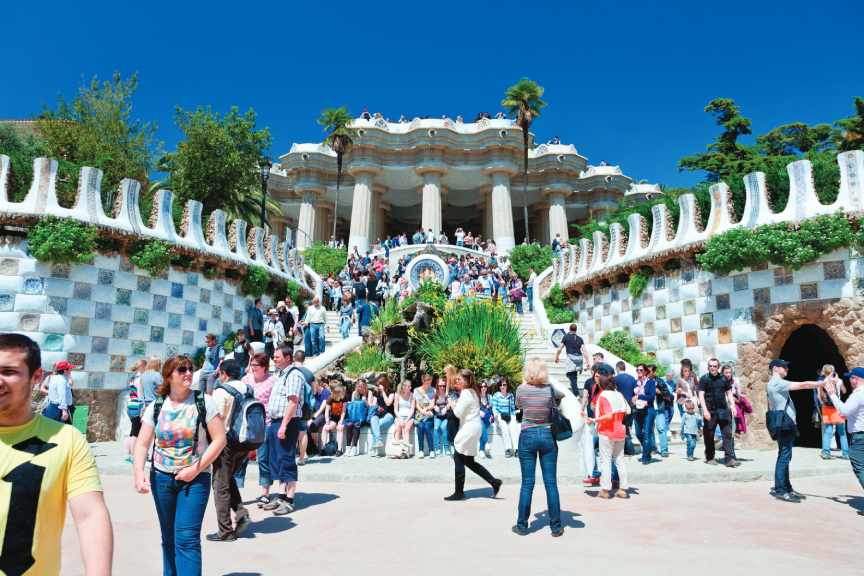
Parc Guell (Photo by vvoe)
Wandering through the skinny streets of the Gothic Quarter, hobnobbing with other travelers over tapas in Barceloneta, and drinking into the wee hours with cute Spaniard in an Eixample gay bar, the city epitomizes everything tourists love about Europe.
I am determined to partake of one major attraction each day during my weekend in the city and this morning I am climbing a steep hill to the entrance of Gaudi’s famed Parc Güell (parcguell.barcelona.com), an urban playground so deliciously surreal even Willy Wonka could not have dreamt it up. Along the way I start a conversation with a handsome Canadian from Toronto who works in finance in the States. I ask him: Do locals pronounce his home city Toron-TOE or Toronno. I’m trying to win an argument here. A coworker of mine insists that the second ‘t’ is silent and although I don’t doubt many folks pronounce it that way, I feel I like I scored a victory when my new North American friend replies “Toron-TOE.”
Magnificent Parc Güell is a UNESCO World Heritage Site sitting atop Carmel Hill in Barcelona. Located well outside the city center, it is beloved for its fantastic views. Originally conceived by Spanish entrepreneur and industrialist Eusebi Güell as a housing development for the city’s poshest residents and commissioned to renowned architect Antoni Gaudi, it was officially established as a public park in 1926. Like all of Gaudi’s Barcelona works, it’s curvy, fantastical, playful and highly photogenic, though the latter characteristic significantly increases the risk of getting whacked by selfie-wielding tourists.
Its most prominent feature is, of course, its main terrace and its ribboned bench seating which is constructed of mosaic tiles and meant to resemble a sea serpent. From here there is quick access to other park highlights like the Hansel and Gretel-inspired administration and care taker’s lodges, the beloved Dragon Fountain, and the Escalera Monumental, which leads to the Hypostyle Room where Doric-style columns support a white-domed ceiling. Don’t miss strolling the outer walls of the park, which are marked by large, candy-striped medallions featuring the words “Parc” and “Güell” on them. For me, they are a highlight.
Though I am reveling from winning the Toronto argument with my coworker from back home, I do take her recommendations seriously. A self-proclaimed Barcelona fanatic, she recommends numerous places she knows I’ll love and one such place is family owned La Pepita (lapepitabcn.com), a youthful tapas restaurant in the Eixample that epitomizes the city’s uncanny ability to make everything Instagrammable. Much of the restaurant is adorned with plants, cheerful artwork, and customer graffiti. I plop down my American butt at the counter and order asparagus in a vinaigrette of ginger and cacao, traditional fried potatoes, and calamari rings with a kimchi mayo. Everything is outstanding and I love that La Pepita is squarely off most tourist’s radars.
There’s enough time left in my afternoon to sample one of Barcelona’s many beaches. Thanks to the 1992 Summer Olympics, the city completely transformed its waterfront including the creation of 2 kilometers of beachfront not far from the city center and easily reachable via a beachfront promenade called Passeig Marítim (Irbarcelona.org). A fun fact about the sand here is that it was imported from Egypt. There is a clothing-optional beach along this stretch called Platja San Sebastian and I arrive with beach towel in hand to check it out.
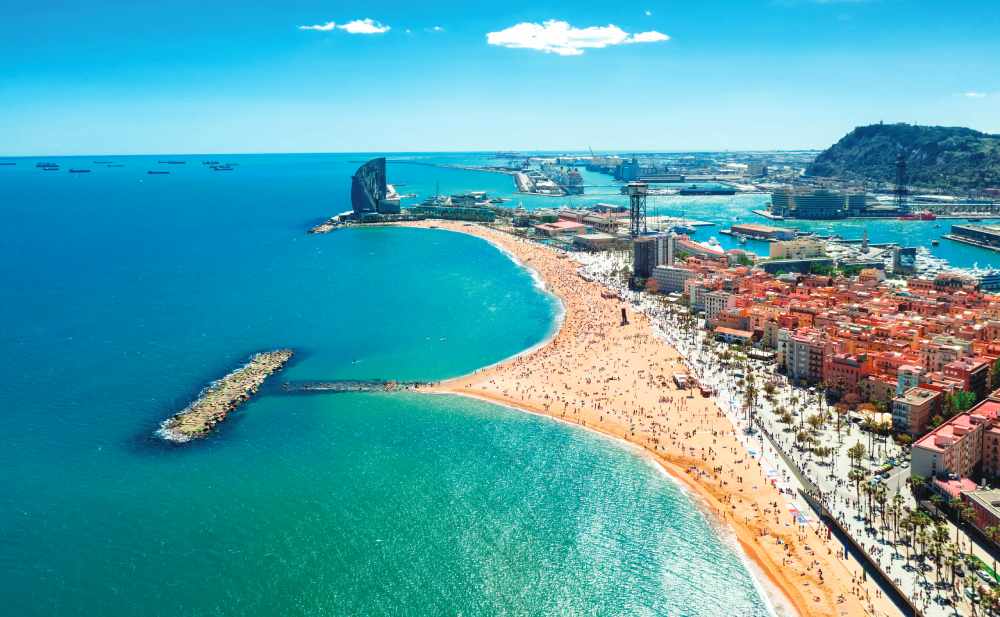
Sant Miquel Sebastian Plage in Barceloneta (Photo by Shevdinov1)
The beach is fairly crowded, even late in the afternoon when I finally stumble upon it, and about half the folks here are nude, a third of whom I estimate are gay men. What startles me is how close the beach sits to the promenade where throngs of tourists are strolling. None seem to notice the nude hippie striking an advanced yoga pose right near the water’s edge, the smatterings of unclothed couples locking arms as the sun begins its initial farewell, or the occasional naked Spaniard strutting right up to the promenade to hose the sand off his body. After crisping both of my sides for an hour or so, it’s back to my vacation rental for a long nap.
A German, a Venezuelan and two Spaniards walk into a bar. It sounds like the beginning of a tasteless joke, right? In this case it refers to a chance encounter with four handsome fellas and the auspicious start of a raucous night on the town. It’s barely 8 P.M. on a Friday and already this queer quartet and I are lined up out the door to get into Candy Darling (candydarlingbcn.com), a queer bar named for the Warhol superstar, transgender icon, and muse to indie band the Velvet Underground. A long hallway marked with the neon silhouette of a genderqueer person in a swan dive pose opens onto a funky room boasting bleacher-style seating and Ziggy Stardust-era projections of Bowie. Inexplicably, a few children are running around. I order a Rainbow vodka, a tutti frutti cocktail served in a large mug and garnished with candied lime and a gumdrop and have a seat.
As it happens, I plop down right next to the same four guys who were in line behind me just a few minutes ago and one of them sidles right up to me and says hello. His name is Luis and he is a bisexual researcher from Barcelona who is now based in Brussels, but in town visiting family. His friends include Alex, a dashing and mustachioed blonde German wearing an Addidas shirt who humors me in my attempts to speak German; Alex’s older plastic surgeon beaux Rodrick who is Venezuelan and wears overalls; and another friend named Luciano. Sipping my rainbow vodka, I am unaware of how fortuitous this chance encounter is, but as they finish their drinks and beckon me to follow, it’s clear I am hitting the town with them.
As I follow this quartet of hottie homos I realize we are headed in the opposite direction of the Eixample, home to the bulk of BCN’s gay bars. This, I realize, will be no ordinary bar crawl. Our first stop is La Casa de la Pradera in the Raval. I can hardly describe the joint since we ditch the inside in favor of the bar’s sprawling outdoor terrace, though I recall the stark interior being festooned with queer artwork. Alex tells me its lesbian owned, or did he say only that the bar is women owned? One thing I do know is that it is celebrating its 10-year anniversary and that it has a reputation for hosting a diverse LGBTQ+ and hetero-friendly crowd.
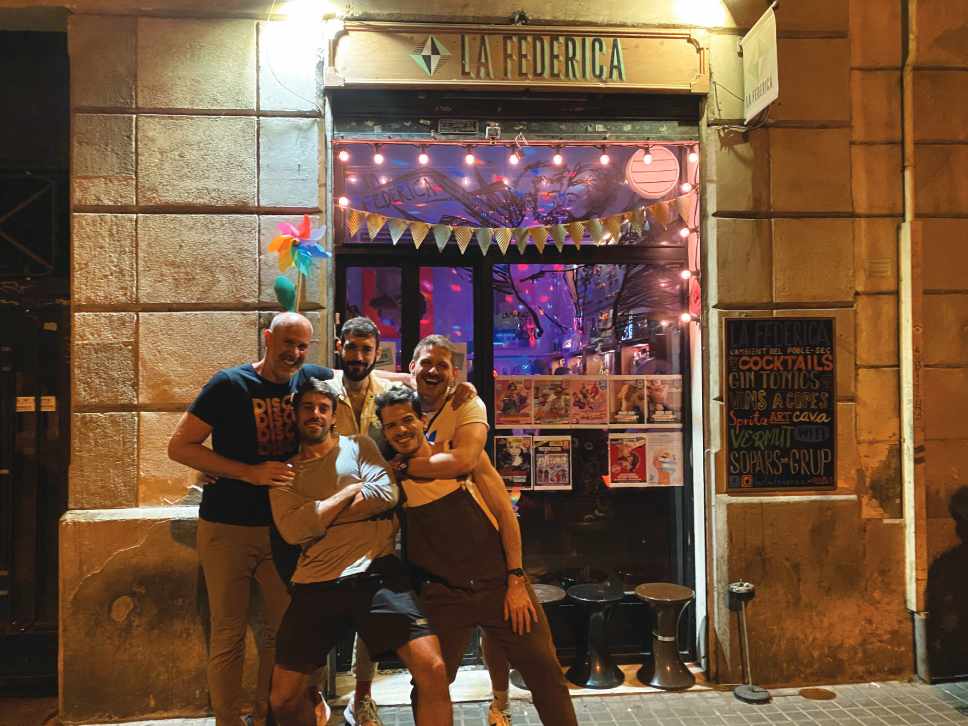
La Federica (Photo by Jason Heidemann)
Next, there’s a pit-stop for savory pastries, though because I am several drinks in at this point I am unable to recall whether this late-night nosh included traditional empanadas or sambusacs (Middle Eastern savory pastries). It doesn’t matter because drunk food is not meant to be named and now it’s onward to La Federica (facebook.com/barlafederica), my favorite stop of the evening. Located in El Poble-sec, a neighborhood famous for its 19th-century architecture and lively tapas bars, this slim, shoebox of a bar is owned by two very cute gents, both named Albert and both total dreamboats. Together they have created a bar that is cheerful, lively, and outrageously fun.
The entire evening is a lovely blur that alas ends with a missed opportunity. After hours of flirting with one another, sadly neither myself nor the Spaniard Luis can host. Instead, the foursome spin me in the direction of my vacation rental and away I stumble.
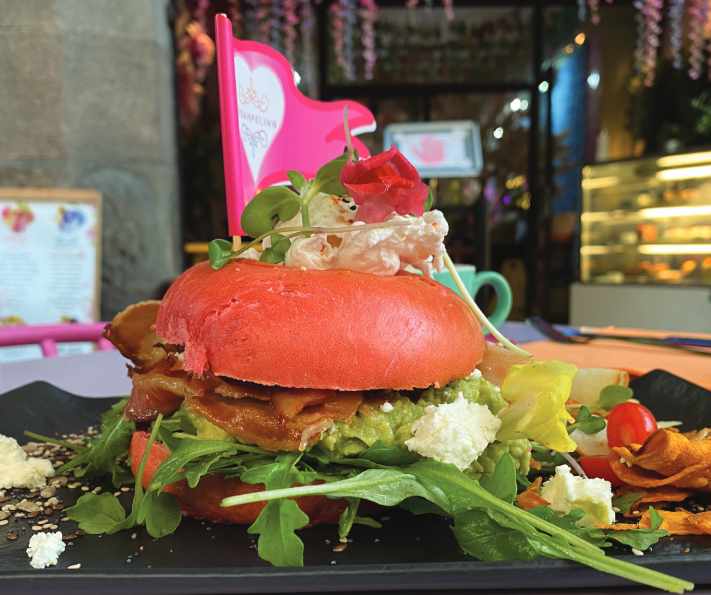
Eixampeling Brunch Cafe and Bar (Photo by Jason Heidemann)
If Carrie Bradshaw married Javier Bardem and ran off to Spain, Eixampling Brunch Café & Bar (eixampeling.com) is where she and her new girlfriends would dine. The punny menu includes BeyoncEgg (poached eggs with smoked salmon, spinach and hollandaise sauce), Crustina Eggullera (the same dish, but with smoked serrano ham instead of salmon), and the disgustingly sweet Pancake My Eyes Off of You (pancakes with strawberry and banana, choc-hazelnut sauce and crushed Oreos). Bright, cheerful and chock full of gays and gal pals, whatever mistake you made last night, this is where you come to discuss it the next morning over mimosas and matcha. I enjoy a simple smashed avo on a bagel and a latte before dashing off to see the city’s most famous sight.
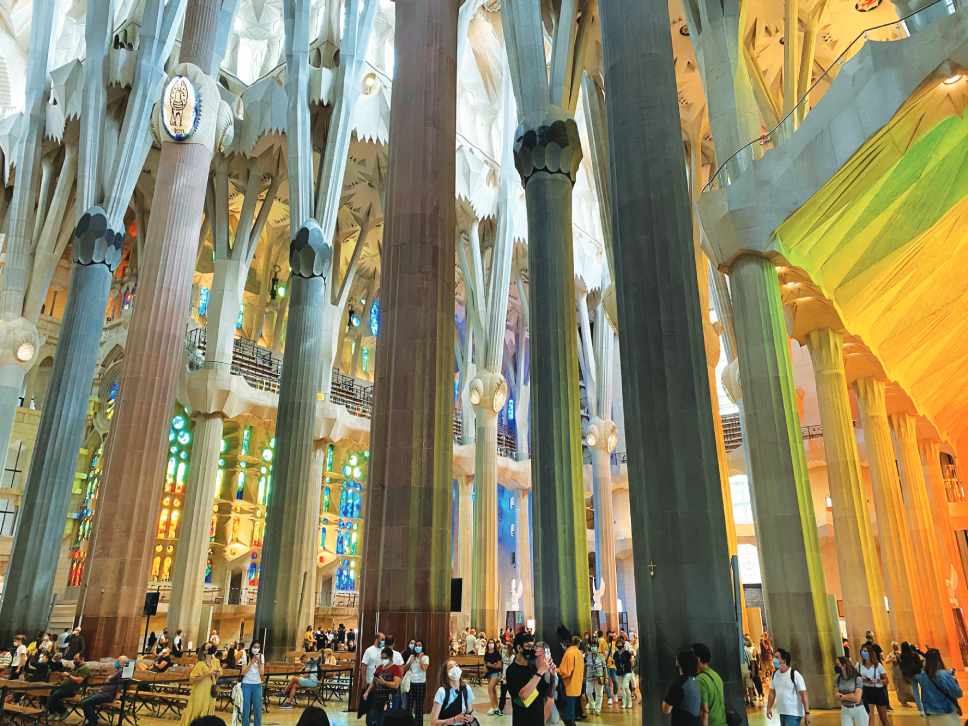
La Sagrada Familia (Photo by Jason Heidemann)
From a distance, the spires of La Sagrada Familia (sagradafamilia.org) resemble a ghoulish and sinister crown, something to be worn by the victor at the end of a Game of Thrones-style showdown. Up close, of course, this is Gaudi’s unfinished masterpiece and Barcelona’s most-visited attraction. It is also a bit of a tourist nightmare. Even off season there are hundreds lined up to visit on this Saturday morning, the entire structure is ringed with souvenir shops and fast-food joints like Burger King, KFC, and Taco Bell, and all your precious photos will need digital touch ups to edit out the numerous cranes surrounding the structure. But it’s also a must-do at least once.
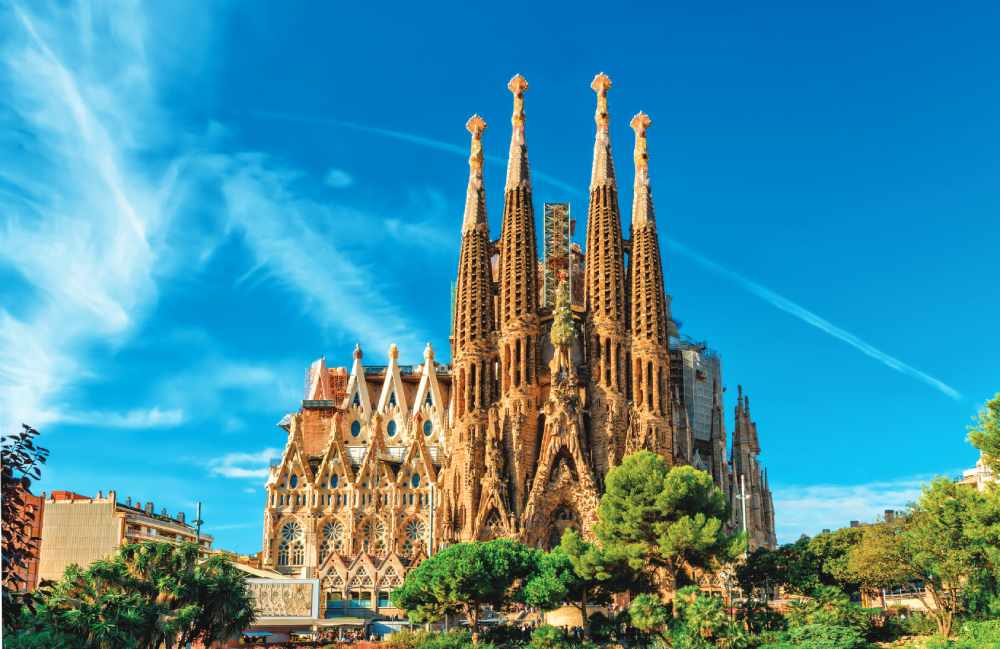
La Sagrada Familia (Photo by Valery Egorov)
A work-in-progress since Gaudi’s passing in 1926 (Gaudi is buried in the crypt), this minor basilica has suffered numerous setbacks during its more than 100-year building period including Gaudi’s death and also the outbreak of the Spanish Civil War in 1936, which set construction back 15 years. It only reached its 50% completion mark in 2010 and a new projected finish date of 2026 has since been pushed back due to the Covid-19 pandemic.
But what a marvel! A mix of Gothic and Art Nouveau architecture, the basilica is striking both from a distance and up close where fantastic details like the star atop the Virgin Mary’s spire and the lushly ornate nativity façade are revealed. Though drab color, the inside of the church offers a breathtaking contrast. Here gargantuan columns stretched like pulled taffy reaching for the ceiling, while striking, stained-glass windows provide portals of sunlight throughout that drench visitors in a rainbow glow. The official Sagrada Familia app allows for a self-guided tour.
The next day I head for Platja Mar Bella (no website), Barcelona’s main gay beach. And although my hosts insist Mar Bella is all tourists and that there is a better nudist beach outside of town (which I will visit tomorrow), I’m keen on checking out the city’s most famous LGBTQ+ sunbathing spot. I am not disappointed. A 20-minute trek via subway line L4 coupled with a 10-minute walk along Bilbao Street leads straight to the beach. Because it’s a weekend and a fantastically sizzling one at that, the gay section is not at all hard to find. The sand is lined with about a million bronzed boys wearing snug bikinis or nothing at all (Mar Bella is clothing optional), and in the middle of it all is Chiringuito BeGay (chiringuitobegay.com) bar, an open-air restaurant featuring passable food and mediocre service, but providing essential relief after a few hours of baking in the Catalan sun.
As with Platja San Sebastian, what’s striking about Mar Bella is once again how blasé the Spaniards are with nudity. Near the top of the accessibility ramp leading to the beach, a naked, Adonis-like creature who looks plucked straight from the vintage pages of Honcho magazine casually chats with his friend, blissfully nonchalant about the many tourists walking right by him. I want to make friends with him and everyone else at this beach, but nobody wants to talk to the guy who stares and drools. I am reminded that it’s Folsom weekend in San Francisco thanks to placing my towel near a group of loud Americans who tell the Spaniards they’re flirting with they skipped the fetish fest on the basis that BCN boasts “enough faggotry.”
I know it’s uncool to have dinner in Spain too early, but at 7 P.M. tapas restaurant El Chigre 1769 (elchigre1769.com) is already fully booked for the entire night, and I’m allowed only to huddle at the open-air counter space outside the restaurant. Located in the romantic Gothic Quarter in the shadows of Basilica Santa Maria Del Mar, I am here based on a recommendation from a French couple I stayed with in Paris a few days earlier and am currently stumbling over what to order to drink. A chilled fino or manzanilla sherry is common I think, but the couple standing next to me share a taste of their cider and insist I order it. It’s served with an oxygenator and meant to be sipped like a shot. From tradtional croquetas (dumplings) to a heartier pulpo (octopus), everything at El Chigre is amazing including the ambience. A light rain dampens my clothing, but not my mood.
This is my last night out in the city and I need to devote it to checking out the gay bars around the Eixample. I visit three. The first of which is the aptly named bear bar, Honey (facebook.com/honeyfurrybar). This newish joint boasts a slideshow of soft-core bear porn (Tom of Finland imagery, furry fellas in Speedos, chubby guys in harnesses and, inexplicably, lots of slides of actor Alec Baldwin). I strike up a conversation with an expat from the States, a retired therapist named Bob. He and his Chilean companions are nice enough and help break the loneliness that can come with solo travel.
I also check out La Chappelle, which is near Honey and is famous for the religious iconography hanging on its walls. One more stop I make is at a cruise bar called Night. which features a dark room and cruising area. It’s a little early during my visit for frisky fun, not that it’s stopping the occasional Spaniard from unbuckling his belt as makes a beeline for the back.
It’s Sunday morning, my last day in the city, and I’m having brunch at a lovely little place I’ve discovered called Oma (omabarcelona.com). I arrive right when it opens, and it quickly gathers a crowd. The space is lovely. It boasts the kind of shabby chic aesthetic you see at so many places these days, and includes mismatched tables and chairs, a couple broken-in sofas, a vintage bike in the corner, brick walls, and so forth. I order the eggs Benedict and it is mighty good.
My last bit of sightseeing is to check out both Casa Batlló (casabattlo.es) and Casa Milà (lapedrera.com). two Gaudi icons located within a stone’s throw of each other and easily reachable via Avinguda Diagonal. There are no tours at this hour, so the visit is purely to admire the facades. Batlló, a remodel of a previously existing structure, is the most fairytale of the two. Milà, however, is famous for its walkable rooftop terrace. I’m kicking myself that I didn’t plan for guided tours of each.
Before I know it, I’m back at my vacation rental packing up. The airport bus runs right outside my building and in an hour I’ll be boarding it, though I would give anything for a few extra days in Spain.


